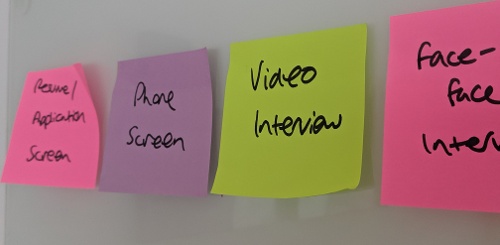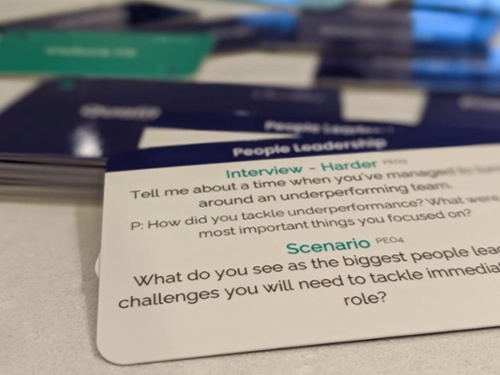This guide will cover:
You’ve put the job ad up? Check. You’ve received lots of applications? Check. Now you’re stuck trying to pick 5-6 candidates to interview based on all these words on a few pieces of paper. Let’s face it: resumés suck for everyone:
Resumés seem to be a necessary evil. We need a uniform method for people to apply, but we also need a better way for people to be able to sell themselves for a role.

For the purpose of this guide, we are talking about asynchronous, or one-way video interviews. This typically involves a candidate clicking on a link and answering a selection of pre-written questions in their own time. These video responses are recorded and then sent to you to review. We’re not talking about two-way video interviews (you know, the kind where you spend 15 minutes getting it to work, then the connection keeps dropping out, so you miss one in every ten sentences because everything is out of sync…).
One thing you’ll notice when you implement video interviews is that not everyone you progress to this stage will go through with completing the video interview. Some level of drop-off is inevitable. There are, however, several things you can do to minimise drop-off, including how you communicate the process to candidates and how you design the questions (amongst other things). This guide will cover all these areas.
There are a ton of providers out there, so how do you choose which one will be right for you? You could put the names in a hat and randomly pick one, but chances are you’ll end up with something you don’t want. The following criteria are based on the implementation of video interviews for ongoing recruitment (not just a one-time project). For ongoing recruitment, you ideally want the following features:

Definitely don’t use them after you’ve already met the person face-to-face for a real-life interview. It will not only confuse the candidate, but it will also confuse you. You’ll be left trying to figure out why the calm and relaxed person you met two days ago all of a sudden appears nervous and fidgety (hint: it’s because they think it’s really weird that you’re asking for a video interview after already meeting them). Video interviews are a fantastic screening tool, so you should use them early in the recruitment process.
As a general rule of thumb, you want as many candidates as possible to complete a video interview. By doing this, you’re giving people the benefit of the doubt. I’ve seen many candidates who only look 50/50 on paper shine when given the chance to complete a video interview. This is because, that's right you've guessed it, resumés suck at helping people sell themselves!
For volume roles where you will receive a large number of applications, I’d recommend video interviews as an immediate next step for anyone who passes the resumé/application screening process (bonus points if, rather than a resumé screen, you use a dedicated and specialised screening tool that goes beyond years of experience and looks at culture fit and/or personal attributes).
For more senior roles, where you’ll receive a more moderate amount of applications, I recommend video interviews after completing a brief phone screen. This gives you a chance to personalise the process, but also explain why you’re using video interviews. Candidates for more senior-level roles will sometimes resist a video interview – they may try to get around it by requesting a face-to-face meeting instead. For start-ups/scale-ups this is a big red flag for me. So much about life in a fast-growing business is about embracing ambiguity and getting sh!t done, even if it’s uncomfortable. If you can’t deal with a video interview, how are you going to be able to deal with an ever-changing business environment? I have also generally found that people who want a role will embrace the opportunity to paint a picture of themselves beyond their resumé.
For very senior/niche roles where you won’t get a huge amount of applications, there is no real need to use video interviews. Take the time and meet with candidates personally (it will be worth it in the long run).
As I’ve already mentioned, you will get some candidate drop-off with video interviews. Not everyone you send the link to will take the time to complete a video. I consider this a great natural screening tool; the ones who can’t be bothered completing a video generally aren’t too invested in the company/role in the first place.
The key is to do your part – make sure your communications are clear, and that you’ve created an attractive proposition through your job adverts (and other means). Give people a reason to complete the video! If the job advert is poor, you don’t have a good website or you haven’t sold the company/role, then people won’t bother investing the necessary time to complete a video interview.
In your communications, make sure you talk about why you are using video (e.g. to allow people to bring their experiences to life), and how it fits into the broader selection process. Clearly outline all the steps in the selection process with expected timelines. Show you’re serious and that your selection process is well thought through.
Well, let’s start with what you shouldn’t ask. Don’t ask people naff questions like “if you were an animal which animal would you be?”. While you might want to show that you are a hip, quirky, forward-thinking organisation, stupid video interview questions aren’t the way to do it. Many video interview platforms will allow you to put a video upfront to sell your company and your culture. This is a nice place to have a video of you and your team showcasing your great culture and work environment.

Figuring out what questions you want to ask should begin with scoping out the role. Something which I feel sucks equally as much as a resumé is a job description. Instead of using a job description, sit down with everyone in your team who can provide valid input on what the ideal person for the role will be like, and summarise it on one page. A great tool you can use to capture this is the role canvas [download for free here], which will help you succinctly describe exactly what you’re looking for. The video interview questions should then be constructed around this. The following are types of questions you should look to include:

Too many questions and candidates will press close quicker than if their boss had walked past while they were searching for another job. Too few questions and you won’t have enough information to go beyond the resumés you’ve collected (and remember, resumés alone won’t cut it).
Here are some guidelines about what works well in terms of balancing drop-off and getting the depth you need:
I know it can be tempting to play psychologist, but contrary to poor practice, you shouldn’t be scoring video interviews based on what the person is wearing or the painting you can see in the background. Give each interview a score and comment based on perceived strengths/gaps. Not only is this a good practice to get into (as it enables you to examine your rationale beyond ‘gut-feel’), but it also makes it much easier to provide candidates with feedback. This creates a positive interview experience, even for unsuccessful candidates. Some other tips to keep in mind when scoring:
I’m sold, I need video in my hiring process…so, what next?
Before going full speed ahead, I always recommend doing a pilot or two first with a couple of active roles. Through the pilot process, you will learn a lot about what works and doesn’t work at your company. It’s also a great way to get input from hiring managers on how to shape the process. If you’d appreciate a hand getting started, then feel free to get in touch with us and we’d be happy to help.
Viren Thakrar is a guest blogger on the myInterview blog. Want to talk more about video interviewing? Not happy with your current recruitment process? Got a critical role to fill? Book in a chat here. We help fast-growing companies and forward-thinking leaders kick goals, get results and grow. Our focus is to help you hire, keep and develop great people.

About the Author
Want to talk more about video interviewing? Not happy with your current recruitment process? Got a critical role to fill? Book in a chat here. We help fast-growing companies and forward-thinking leaders kick goals, get results and grow. Our focus is to help you hire, keep and develop great people.
No credit card required